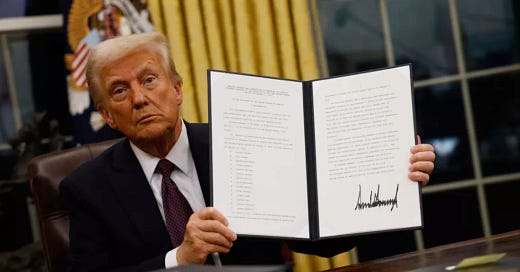Bonus 121: The Unitary Executive Runs Amok
The Supreme Court may (and should) reject the broadest claims of executive power being made by the Trump administration. But it bears significant responsibility for enabling them in the first place.
Welcome back to the weekly bonus content for “One First.” Although Monday’s regular newsletter will remain free for as long as I’m able to do this, I put much of Thursday’s bonus content behind a paywall as an added incentive for those who are willing and able to support the work that goes into putting this newsletter together every week. I’m grateful to those of you who are already paid subscribers, and hope that those of you who aren’t will consider a paid subscription if and when your circumstances permit:
For today’s bonus issue, I wanted to try to step back from the fast-moving developments and take a more holistic look at the stunning amount of power that President Trump has claimed in his first 2+ weeks in office, and its relationship to the “unitary executive” theory—the idea that, because the Constitution vests the executive power in a single person, that person must be able to exercise bureaucratic control over the entire executive branch. As folks who follow the Supreme Court even somewhat closely know, the justices have done quite a lot over the past 15 years—and especially over the past seven—to endorse that theory, and to recognize a degree of constitutionally required presidential control that we’ve never seen before.
To be sure, even the most aggressive academic and judicial proponents of the unitary executive theory have never argued for the amount of power Trump is claiming—from the power to impound funds Congress has appropriated to the power to shutter agencies Congress has created to the power to fire anyone within the executive branch who isn’t sufficiently loyal to the President. To be as blunt as possible, there are no Supreme Court decisions that support those assertions of power, nor do they even logically follow from any plausible reading of the “unitary executive” theory. These assertions are already faring poorly in the courts, and I suspect the Supreme Court, or at least a majority thereof, will be as skeptical as lower courts have been.
And yet, it’s impossible not to think that the Supreme Court’s aggressive moves toward endorsing the unitary executive theory have provided at least some support for what Trump is doing—and has put “on the wall” at least some arguments that would previously have been off of it. What’s worse, the breakdown in intra-branch and inter-branch accountability that we’re already seeing in the opening weeks of the second Trump administration is the exact cost of the Supreme Court’s executive power jurisprudence that its critics have been warning against for decades. To make a long story short, the Supreme Court didn’t cause this mess (unless you believe that Trump would never have been elected but for the immunity ruling; I’m not convinced), but its aggressive and controversial embrace of executive power has almost certainly enabled it.
For those who are not paid subscribers, the next free installment of the newsletter will drop on Monday morning. For those who are, please read on.
Keep reading with a 7-day free trial
Subscribe to One First to keep reading this post and get 7 days of free access to the full post archives.




